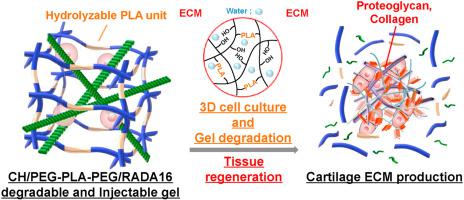Materials Today Advances ( IF 8.1 ) Pub Date : 2021-02-18 , DOI: 10.1016/j.mtadv.2021.100131 S. Ishikawa , K. Iijima , D. Matsukuma , M. Iijima , S. Osawa , H. Otsuka

|
Hydrogels are used as cell culture scaffolds for tissue engineering and regeneration. These hydrogel designs are inevitably complicated because favorable scaffolds should have stiffness to sustain alignment of the cells and mimic the structure of the extracellular matrix (ECM) in the targeted tissue. However, the incorporation of biodegradability, which is an essential property for practical applications, into complex hydrogels is not easily attained. Herein, we established a new concept for constructing biodegradable hydrogels with an interpenetrating polymer network (IPN) structure, composed of a covalent cross-linked network and peptide self-assembling networks, to solve this dilemma of selecting between the complicated structure and facile biodegradability. Assuming that the diffusion of the self-assembled peptides out of the IPN hydrogel would be facilitated by the disappearance of the covalent cross-linked networks, we designed an IPN hydrogel with chitosan cross-linked with poly(ethylene glycol)-block-poly(dl-lactide)-block-poly(ethylene glycol) as the covalent cross-linked networks with hydrolysis properties and RADA16 peptides as the self-assembling networks. This IPN hydrogel showed overall degradation, based on hydrolysis of the poly(dl-lactide) domain, and was more effective as a scaffold for culturing chondrocytes to form articular cartilage tissues compared with the IPN hydrogel without the poly(dl-lactide) domain, likely owing to the promotion of ECM deposition. These results verified our strategy of constructing a hydrogel with a complicated, but biodegradable, structure.
中文翻译:

一种具有可生物降解性的互穿聚合物网络水凝胶,通过可水解的交联网络控制自组装肽的行为
水凝胶用作组织工程和再生的细胞培养支架。这些水凝胶的设计不可避免地复杂,因为有利的支架应具有一定的硬度,以维持细胞的排列并模仿目标组织中的细胞外基质(ECM)的结构。然而,不容易实现将生物降解性(其对于实际应用而言是必不可少的性质)结合到复杂的水凝胶中。在本文中,我们建立了一种构建具有互穿聚合物网络(IPN)结构的可生物降解水凝胶的新概念,该结构由共价交联网络和肽自组装网络组成,以解决在复杂结构和易于生物降解之间进行选择的难题。块-聚(DL -丙交酯) -嵌段-聚(乙二醇)作为水解性和RADA16肽作为自组装网络共价交联的网络。这种IPN水凝胶基于聚(dl-丙交酯)域的水解而显示出整体降解,并且与没有聚(dl-丙交酯)域的IPN水凝胶相比,作为培养软骨细胞以形成关节软骨组织的支架更有效,可能是由于ECM沉积的促进。这些结果证实了我们构建具有复杂但可生物降解的结构的水凝胶的策略。











































 京公网安备 11010802027423号
京公网安备 11010802027423号